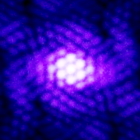|
Juno Thread
|
|
| spacer | Date: Sunday, 03.07.2016, 03:59 | Message # 31 |
 Star Engineer
Group: Users
 Israel
Israel
Messages: 1258
Status: Offline
| no no no you are probably very wrong, the red lines on europa and other bodies probably isnt a bacteria!
the radiation on the surface is huge and any type of organic life would not survive there.
this lines are probably some kind of salt that was radiation-bombarded for many years.
this salt could arrive to the surface from the subsurface satly ocean.
"we began as wanderers, and we are wanderers still"
-carl sagan
-space engine photographer
Edited by spacer - Sunday, 03.07.2016, 03:59 |
| |
| |
| Hornblower | Date: Sunday, 03.07.2016, 04:02 | Message # 32 |
 World Builder
Group: Users
 United States
United States
Messages: 714
Status: Offline
| True. It is still a candidate for life. I am 50% sure there is something in that sea.
|
| |
| |
| Watsisname | Date: Sunday, 03.07.2016, 04:16 | Message # 33 |
 Galaxy Architect
Group: Global Moderators
 United States
United States
Messages: 2613
Status: Offline
| Quote Hornblower (  ) Maybe! It's hard to tell because we have no data yet. A solid hydrogen-helium alloy would be cool!
Lol, we do have data from previous missions. Composition of Jupiter's interior is determined by models of planetary density as a function of radius, which must fit with observed gravitational field. These show the core is about the size of Earth and is a combination of rocky and metal material.

|
| |
| |
| spacer | Date: Sunday, 03.07.2016, 10:17 | Message # 34 |
 Star Engineer
Group: Users
 Israel
Israel
Messages: 1258
Status: Offline
| that big antena covered by metal for protection of juno...looks exactly like a probe ready to be launched like it was on cassini and galileo.
at first i thought it is a probe but now i see its antena covered by metal for protection 
a probe would be cool
"we began as wanderers, and we are wanderers still"
-carl sagan
-space engine photographer
|
| |
| |
| Wwadlol | Date: Sunday, 03.07.2016, 11:51 | Message # 35 |
 Space Pilot
Group: Users
 Norway
Norway
Messages: 107
Status: Offline
| Quote spacer (  ) the radiation on the surface is huge and any type of organic life would not survive there.
But this life could be completely different compared to ours. I believe that life can exist at any place if it starts to exist at the right time.
But then again, you could be right. If life originated underneath the ice, the bacteria would not be used to the radiation.
Unless the life is ancient, and has been exposed for 100,000's years. But the speed of their evolution could be different too, Or maybe evolution doesn't even exist on Europa. What if evolution is a concept that exists only on Earth?
|
| |
| |
| spacer | Date: Sunday, 03.07.2016, 11:56 | Message # 36 |
 Star Engineer
Group: Users
 Israel
Israel
Messages: 1258
Status: Offline
| Wwadlol, true, i am like you believe that there could be lot of different types of life out there.
but in europa case, its probably a life under the ice that protect them from the radiation. and if its organic life like us, i think they may not survive on the surface and without any atmosphere. but there is that water bears here on earth that can survive extreme conditions... so who know? 
"we began as wanderers, and we are wanderers still"
-carl sagan
-space engine photographer
|
| |
| |
| steeljaw354 | Date: Sunday, 03.07.2016, 13:53 | Message # 37 |
 World Builder
Group: Users
 Pirate
Pirate
Messages: 862
Status: Offline
| Quote no no no you are probably very wrong, the red lines on europa and other bodies probably isnt a bacteria!
the radiation on the surface is huge and any type of organic life would not survive there.
this lines are probably some kind of salt that was radiation-bombarded for many years.
this salt could arrive to the surface from the subsurface satly ocean.
What if it adapted? The Earthcentric view is one view, if you look at things from other views, more possibilities, and thus it may be life but the only way to tell is to send a probe to the cracks to analyze the cracks. Earthcentric view means narrow minded. Maybe the red streaks are dead bacteria, ones that were in the water when it cracked open and poured out and died afterward, maybe the water is red somehow? Ammonia?
Ganymede may have multiple oceans.

Edited by steeljaw354 - Sunday, 03.07.2016, 14:06 |
| |
| |
| Watsisname | Date: Sunday, 03.07.2016, 15:17 | Message # 38 |
 Galaxy Architect
Group: Global Moderators
 United States
United States
Messages: 2613
Status: Offline
| Quote steeljaw354 (  ) What if it adapted? The Earthcentric view is one view, if you look at things from other views, more possibilities, and thus it may be life but the only way to tell is to send a probe to the cracks to analyze the cracks.
Planetary scientists are way ahead of you. 

|
| |
| |
| spacer | Date: Sunday, 03.07.2016, 15:21 | Message # 39 |
 Star Engineer
Group: Users
 Israel
Israel
Messages: 1258
Status: Offline
| Watsisname, so radiation bombarded is what turned the salts to red color i guess. 
but the salts origin could still be from the subsurface ocean! its still a clue! so its still amazing steeljaw354,
"we began as wanderers, and we are wanderers still"
-carl sagan
-space engine photographer
|
| |
| |
| Hornblower | Date: Sunday, 03.07.2016, 15:27 | Message # 40 |
 World Builder
Group: Users
 United States
United States
Messages: 714
Status: Offline
| Quote steeljaw354 (  ) Ganymede may have multiple oceans
Different sources say different things
|
| |
| |
| Watsisname | Date: Tuesday, 05.07.2016, 02:36 | Message # 41 |
 Galaxy Architect
Group: Global Moderators
 United States
United States
Messages: 2613
Status: Offline
| Orbital insertion burn about to begin. Follow at NASA TV. :)
This is an excellent free visualization program for following along with Juno in real time as it enters into orbit.
http://eyes.nasa.gov/
Added:
Burn complete! JUNO is now in its intended orbit! 
"Welcome to Jupiter"

|
| |
| |
| spacer | Date: Tuesday, 05.07.2016, 03:56 | Message # 42 |
 Star Engineer
Group: Users
 Israel
Israel
Messages: 1258
Status: Offline
| mmm i see they all cheering right now like we know its successful. but dont we need to wait 40 minutes until we know its succeed?
because 40 light minutes to reach earth
"we began as wanderers, and we are wanderers still"
-carl sagan
-space engine photographer
|
| |
| |
| spacer | Date: Tuesday, 05.07.2016, 05:18 | Message # 43 |
 Star Engineer
Group: Users
 Israel
Israel
Messages: 1258
Status: Offline
| allready new data arrived of something we didnt know yet! :)
its seems that callisto is dimmer than the other galilean moons.
as we can see here:
https://www.youtube.com/watch?v=kjfQCTat-8s
"we began as wanderers, and we are wanderers still"
-carl sagan
-space engine photographer
Edited by spacer - Tuesday, 05.07.2016, 05:19 |
| |
| |
| Wwadlol | Date: Tuesday, 05.07.2016, 05:48 | Message # 44 |
 Space Pilot
Group: Users
 Norway
Norway
Messages: 107
Status: Offline
| spacer, That's cool! Maybe it's covered in some sort of dust other than snow?
Edited by Wwadlol - Tuesday, 05.07.2016, 05:59 |
| |
| |
| Watsisname | Date: Tuesday, 05.07.2016, 06:14 | Message # 45 |
 Galaxy Architect
Group: Global Moderators
 United States
United States
Messages: 2613
Status: Offline
| Quote spacer (  ) mmm i see they all cheering right now like we know its successful. but dont we need to wait 40 minutes until we know its succeed?
Mission control operates according to the arrival of signals from Juno at Earth, not what Juno is doing "right now". So when they were cheering, it's because they just received the tone signaling "burn completed" as planned. Of course, due to the time delay, the burn had already completed 48 minutes earlier. 

|
| |
| |